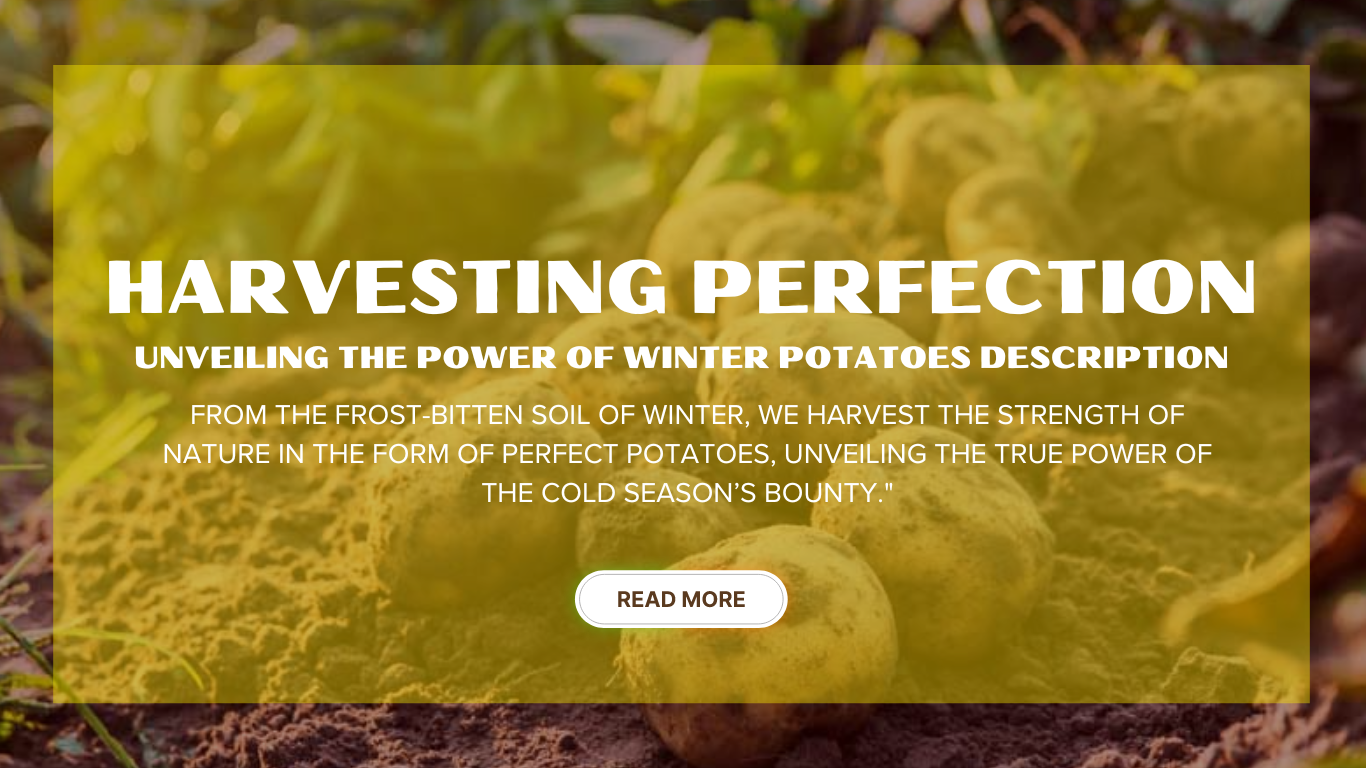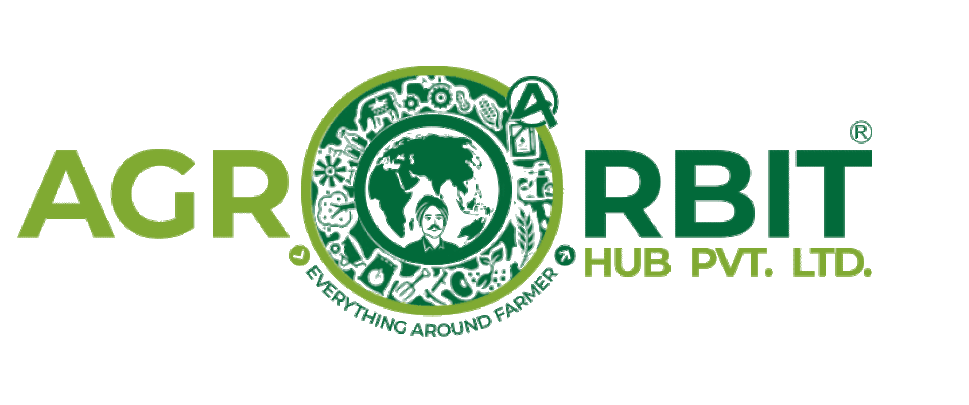

Harvesting Perfection: Unveiling the Power of Winter Potatoes
Winter is often considered a challenging season for many
crops, but for potatoes, it’s a time when they truly shine. In this in-depth
exploration, we uncover the magic behind winter potatoes—how they thrive under
frosty conditions, and why this cool-weather crop is a favorite among farmers
and gardeners alike. Whether you're cultivating potatoes for commercial farming
or growing them in your backyard garden, winter potatoes hold the key to
unlocking a perfect harvest, filled with quality, flavor, and yield.
Why Winter is the Perfect Time for
Potatoes
Potatoes are one of the most versatile and resilient crops,
and they are particularly well-suited for colder climates. Winter provides
unique conditions that can significantly enhance the growth, taste, and overall
health of potato plants. While some crops struggle in the cold, potatoes have
adapted to frost-touched soils and shorter daylight hours. These conditions not
only improve the flavor and texture of the tubers but also protect them from
certain pests and diseases that are more prevalent in warmer months.
Cold Stress for
Better Growth: Contrary to
what many might believe, the cooler temperatures associated with winter can
trigger positive stress in potato plants. This "cold stress" enhances
their resistance to environmental challenges, leading to healthier, stronger
plants with greater tuber quality. The slow growth induced by cooler
temperatures allows for a more controlled and uniform development of the
tubers, resulting in a superior harvest that is not just abundant, but also
packed with nutrients and flavor.
Flavor Enhanced by
Frost: The magic of
winter potatoes lies in the flavor. As the temperatures drop, starches in the
potatoes begin to convert into sugars, giving the tubers a naturally sweeter
and richer taste. This transformation is one of the reasons why winter potatoes
are often considered more flavorful than their summer counterparts. The
frost-kissed fields play a vital role in boosting not only the taste but also
the texture, making winter potatoes a favorite in kitchens and restaurants
worldwide.
Cultivating Winter Potatoes: A
Step-by-Step Guide
To fully harness the power of winter potatoes, it’s
important to understand the nuances of growing them during the colder months.
Here, we offer a comprehensive guide to cultivating winter potatoes, ensuring
that you can achieve a perfect harvest.
1. Choosing the Right Varieties: Not all potatoes are
created equal, and when it comes to winter cultivation, selecting the right
variety is crucial. Some of the best potato varieties for winter growing
include "Russet," "Kennebec," and "Yukon Gold."
These varieties are known for their cold tolerance and ability to withstand
frost. Researching and choosing the right potato seed will set the foundation
for a successful winter crop.
2. Soil Preparation and Planting: The health of the
soil plays a pivotal role in potato farming. Potatoes thrive in well-drained,
loose soil rich in organic matter. Before planting, it’s essential to till the
soil, removing any rocks or debris that could hinder tuber development. Adding
compost or well-rotted manure will provide the necessary nutrients for the
potatoes to grow strong. Potatoes should be planted 6-8 inches deep and spaced
12-15 inches apart to give them ample room to spread.
3. Timing is Key: When planting winter potatoes,
timing is everything. Potatoes should ideally be planted in late autumn,
allowing them to establish roots before the first hard frost. This ensures that
they are well-rooted and ready to take on the colder months ahead. In areas
with milder winters, you can plant potatoes throughout the winter, ensuring a
staggered harvest in early spring.
4. Irrigation and Care: While potatoes love cool
temperatures, they also need consistent moisture. During winter, natural
precipitation may be enough to keep the soil moist, but in drier regions,
supplemental watering is essential. Overwatering should be avoided, as it can
lead to rot. Mulching is an excellent practice for winter potato crops as it
helps regulate soil temperature and moisture, while also providing an extra
layer of frost protection.
Winter Potatoes: Benefits Beyond the
Field
The benefits of winter potatoes extend beyond the field and
into the kitchen. Due to their slow growth and enhanced flavor, winter potatoes
are highly sought after in culinary circles. Their naturally sweet and creamy
texture makes them ideal for a variety of dishes, from mashed potatoes and
soups to roasted sides and gourmet entrees. The starch-to-sugar transformation
caused by frost is what gives winter potatoes their melt-in-your-mouth quality.
Health Benefits of Winter Potatoes: Potatoes are not
only a versatile ingredient but also a nutritional powerhouse. Rich in vitamins
C and B6, potassium, and fiber, they are a valuable addition to any diet.
Winter potatoes, in particular, are known for their dense nutrient profile, as
the cold growing conditions preserve their natural vitamins and minerals. They
provide sustained energy and support immune health, making them an ideal food
source during the colder months.
Sustainability and Crop Rotation: Winter potatoes are
also an excellent choice for sustainable farming practices. They can be grown
as part of a crop rotation system, which helps maintain soil fertility and
reduce pest pressures. Additionally, potatoes are relatively low-maintenance, requiring
less water and fewer pesticides than many other crops, making them a more
environmentally friendly option.
Maximizing Your Harvest: Tips and
Tricks
To ensure a bountiful and high-quality winter potato
harvest, it’s important to follow a few best practices:
- Hilling:
As potato plants grow, it’s important to continually hill soil around the
base of the plants. This not only supports the plant but also encourages
tuber growth by protecting them from light exposure.
- Frost
Protection: While potatoes thrive in cooler temperatures, severe frost
can damage the plants. Using frost blankets or row covers during extreme
cold spells can help protect your crops and ensure a successful harvest.
- Harvesting at the Right Time: Timing your harvest is essential to ensuring the best flavor and texture. Winter potatoes should be harvested once the vines have died back and the skins have hardened. This allows the potatoes to store longer and maintain their quality for months.


Insecticides
- Imidacloprid:
Effective against aphids, Colorado potato beetles, and other sucking
pests. It works systemically, providing long-lasting protection.
- Thiamethoxam:
Targets aphids and wireworms, helping to control infestations early in the
growing season.
- Carbaryl:
A broad-spectrum insecticide that controls a wide range of pests,
including beetles and caterpillars.
2. Fungicides
- Mancozeb:
Prevents and controls fungal diseases like late blight and early blight.
It’s often used in rotation with other fungicides to prevent resistance.
- Chlorothalonil:
Effective against a variety of fungal diseases, including leaf blight and
rusts. It’s typically used preventively.
- Metalaxyl:
Specifically targets Pythium and Phytophthora species, which can cause
seed and root rot, as well as late blight.
3. Herbicides
- Metribuzin:
Controls a range of broadleaf and grassy weeds. It can be applied
pre-emergence or post-emergence.
- S-Metolachlor:
Effective against annual grasses and some broadleaf weeds. It’s usually
applied pre-emergence.
- Glyphosate:
A non-selective herbicide often used for desiccation before harvest to
facilitate easier harvesting of potatoes.
4. Defoliants
- Diquat:
Used to desiccate potato vines before harvest, helping to improve tuber
skin set and reduce bruising.
- Carfentrazone-ethyl:
A fast-acting herbicide that can also act as a defoliant, making it easier
to harvest.
5. Biological Control Options
- Bacillus
thuringiensis (Bt): A biological insecticide effective against certain
caterpillars and pests like the Colorado potato beetle, providing an
environmentally friendly control option.
Integrated Pest Management (IPM)
Implementing an Integrated Pest Management approach is
crucial for sustainable potato farming. This strategy involves using a
combination of chemical and non-chemical practices, such as crop rotation,
resistant varieties, and biological controls, to manage pests and diseases
effectively while minimizing pesticide use.
Precautions
- Always
follow label instructions and safety precautions when applying pesticides.
- Monitor
for pest and disease pressure regularly to determine the need for
intervention.
- Consider
the impact of pesticide use on beneficial insects and the surrounding
environment.
Conclusion: The Power of
Winter Potatoes
Winter potatoes are truly a magical crop. Their ability to
thrive in colder months, develop richer flavors, and yield abundant harvests
make them a standout among other seasonal crops. Whether you’re looking to
improve your farm’s productivity or simply enjoy the culinary benefits of these
frost-kissed tubers, winter potatoes offer a unique opportunity to cultivate
excellence. By following the tips and techniques in this guide, you can unlock
the full potential of winter potatoes and turn your harvest into a symbol of
perfection."







